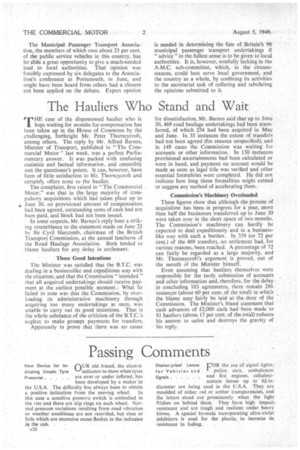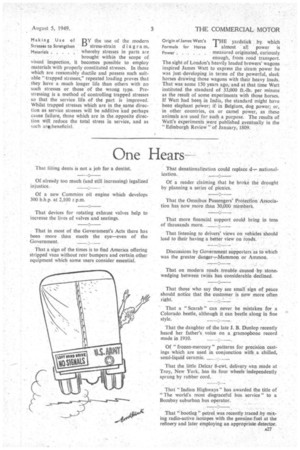Passing Comments
Page 28

Page 29

If you've noticed an error in this article please click here to report it so we can fix it.
New Device for InnUR old friend, the electric dicating Unsafe Tyre `..." indicator to show when tyres Pressures .. ... are over or under inflated, has been developed by a maker in the U.S.A. The difficulty has always been to obtain a positive indication from the moving wheel. In this case a sensitive pressure switch is embodied in the rim and there are slip rings on each wheel. Normal pressure variations resulting from road vibration or weather conditions are not recorded, but rises or falls which are excessive cause flashes in the indicator in the cab. • A26 Shatter-peoof Lenses 'OR the use of signal lights; for Vehicles and police cars, ambulances
Signals and fire engines, cellulose
acetate lenses up to 61-in: diameter are being used in the U.S.A. They are moulded of either red or amber transparencies, and the letters stand out prominently when the fight ?Ashes on behind them. They have high impact resistance and are tough and resilient under heavy blows, A special formula incorporating ultra-violet inhibitors is used for the plastic, to increase its resistance to fading. BI/ the use of the modern stress-strain diagra m, whereby stresses in parts al e brought within the scope of visual inspection, it becomes possible to employ materials with properly constituted stresses. In those which are reasonably ductile and possess such suitable "trapped stresses," repeated loading proves that they have a much longer life than others with no such stresses or those of the wrong type. Prestressing is a method of controlling trapped stresses so that the service life of the part is improved. Whilst trapped stresses which are in the same direction as service stresses will be additive sand perhaps cause failure, those which are in the opposite direction will reduce the total stress in service, and as such are, beneficial.
Making Use of Stresses to Strengthen Materials
Origin of James Watt's THE yardstick by which Formula for Horse I almost all power is Power measured originated, curiously
enough, from road transport. The sight of London's heavily loaded brewers' wagons inspired James Watt to express the steam power he was just developing in terms of the powerful, sleek horses drawing those wagons with their heavy loads. That was some 150 years ago; and at that time Watt instituted the standard of 33,000 ftAb. per minute as the result of some experiments with those horses. If Watt had been in India, the standard might have been elephant power; if in Belgium, dog power; or, in other countries, ox or camel power, as these animals are used for such a purpose. The results of Watt's experiments were published eventually in the "Edinburgh Review" of January, 1809.
























































































